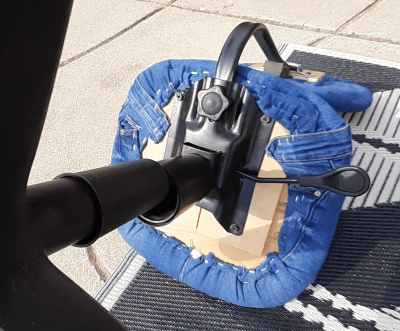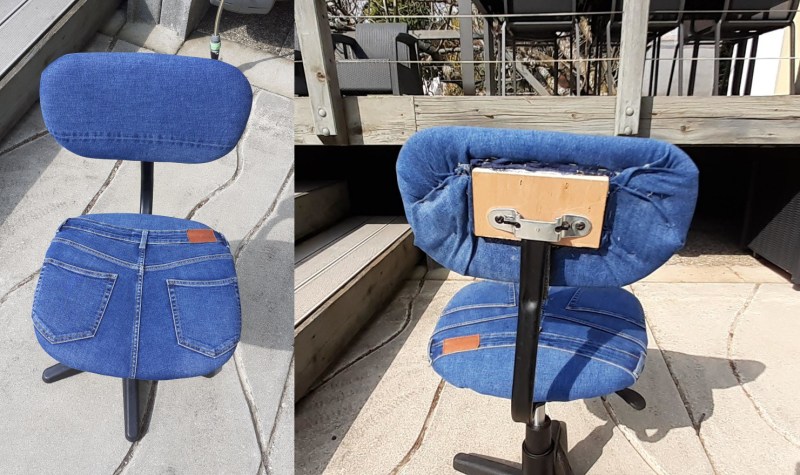What’s the coolest thing about doing upholstery work? Aside from the fact that you end up with a new thing to sit on, sometimes the work only involves clever stapling, and no sewing is necessary. Such is the case with [wyldestyle]’s upcycled jeans chair, which started as a bare-wood swivel number from the dump. In fact, this project is almost completely made from recycled materials, except of course for those staples that hold it all together. And really, that heavy-duty stapler is likely the fanciest tool you’d need to make your own.
 [wyldestyle] didn’t have any furniture foam, and we think that stuff is too expensive, anyway. So the padding treatment begins with a piece of thick Styrofoam that covers the seat screws and bolts. This is glued in place and trimmed down to match the contours of the chair’s seat and back.
[wyldestyle] didn’t have any furniture foam, and we think that stuff is too expensive, anyway. So the padding treatment begins with a piece of thick Styrofoam that covers the seat screws and bolts. This is glued in place and trimmed down to match the contours of the chair’s seat and back.
Here’s where things gets tricky: the next step is wrapping over the stiff foam board with a few layers of that foam sheeting stuff that’s often used as packing material. This sheeting needs to be taut, but pull it too tight, and it will rip.
To add some loft to the chair, [wyldestyle] stretched and stapled the stuffing from an old pillow that was headed for the garbage. The final step is strategically scissoring jean scraps to fit, then stretching and stapling those to cover all the layers underneath. We like the way this chair looks, and would probably try to place pockets somewhere useful, like the back of the chair.
It’s a shame that so much denim goes to waste all over the world. There’s often a lot of life left in most of the fabric, which can be repurposed into all kinds of things, including eyeglasses frames using a wicked set of jigs.















Good job on the chair. Only problem I’ve found with those office chairs is the lift cylinder going out.
Yes, I once dragged one home, and it was a good chair, but slowly I’d sink down. Obviously the reason why such a good chair was tossed out.
A stillson pipe wrench is ideal for replacing a spent gas cylinder, allowing a new one to be inserted. Their ends have pretty standard dimensions, and they come in various lengths.
I’ve always found the hardest part is trying to remove the old cylinder.
Another less elegant method of fixing a sinking cylinder is to attach a pair of vice-grips to hold the height of the chair where the user comfortable.
My life has improved since I realized that office chairs are just a bunch of lego parts. With some mildly clever hacking and careful purchasing, you can customize your chair and swap out the pieces as they break. Seems trivial in retrospect, but things like roller skate swivels, fully metal feet, replacement gas cylinders can all be had easily on the internet for very reasonable prices. The arms, seat, and back can also be purchased, and usually only require minor modification to combine them to a form that is perfect for you.
You should write up your discoveries
I can concur with this. I had two chairs from the same manufacturer that were oppositely broken, I meshed them together into one functional chair that is 95% aluminum framed.
Just last year I had to bore out the holes for the wheels to upgrade to the skate wheels and added a H-Miller headrest to the back with some modifications
At this point the only thing that I expect to break on this chair is the armrest pads, tension springs, or pivot pins.
Altogether this one chair has probably cost me $1000 but that was over the span of 4 years of purchase and I have had a chair to sit in for almost 10 years now.
One of pair of cutoff bottoms served that way for me years ago, the seat wore out on the corners rather quickly. What I am sitting on right now is in need of a cloth wrapping but I want it to come off and be able to be washed or replaced without staples or tacks. I have thought of clamps or 4 or 8 wood screws with the corners folded together holding the cover on by the sides. Like changing sandpaper on a jitterbug, quick on-off.
Fold the edge of the fabric and sew it into a tube, then thread a string through it so you can pull it tight on the underside and tie it up.
Makes the fabric detachable for washing too
Upcycling means converting into something that is more valuable than the -original- manufactured item, not simply fixing up rescued-from-dumpster items.
Recycling means re-manufacturing the items back into something of equal value or quality.
Downcycling means using the item for materials to something of lesser value or quality than the original.
The disagreement I have with the terminology is because people think “upcycling” should simply mean taking something out of the trash and putting it to a new use with a bit of spit and polish. It’s still trash though: patched up old clothes, stapled together chairs – you just don’t mind that it is. This is ersatz material, “mend and make do”.
It is not something “above” recycling such as the name would imply.
“valuable” is relative, that chair might sell more than the original one, and your demonstration of wording rigidity flatly FAILS.
what is the net effect on society for using these terms incorrectly
People can use buzzwords without real understanding. Real change requires understanding.
“Upcycling” may not even have a legit reason to exist. The best route is to not buy something. Then to reuse. Sometimes you have to fix things in order to reuse them. Recycling is the last step, no way to reuse it, so break it down into material that can be reused.b
People have now been trained to take their old electronics to recycling, “it’s old, it has no use”. But how much of that could be reused, directly or after repair? I suspect, but don’t know, that electronic recycling is just breaking it down to components, grab that tiny bit of gold, send the metal case to metal recycling. Only the most obvious stuff gets reused.
“Upcycle” is a trendy word for reuse.
Back in the days when I was a student I carried my stuff in a bag made out of jeans ass. It was pretty cool. Not very safe, but my “valuables” amounted to several copybooks and a pen.
I made an ass bag out of a pair of dusty pink corduroy pants. It’s sort of impractically wide and shallow, but it would be great for certain things.
Tried doing something like this using a towel (readily available in supermarkets in lots of colours.) Held up for about a year before it started to go bald.
Sounds like someone needs a friend. What are you working on these days?
Damn, I’ve had a chair with some jeans ass on it since…2003 or so. Left it to my mum when I moved out and I’m pretty sure she still has it.
Why does the seat of this chair remind me of the song “Fat Bottomed Girls”?
All you’ve gotta do now is hot glue some aquarium gravel to it and I’ll have D-I-WHY bingo!